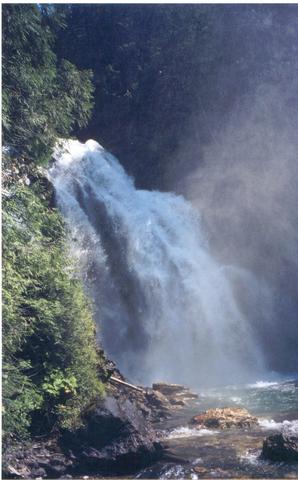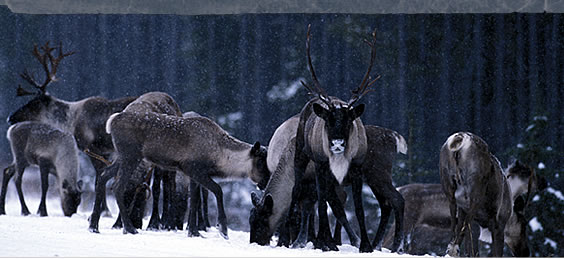The park is also known for some of the oldest rock formations in western Canada. Peters and Margie Lakes sparkle beneath 2697 metre high Mount Fosthall, the highest peak in the park and part of the rugged Monashee Range of snow-capped peaks that surround the park.
According to BC Parks, "Lucky visitors may get a glimpse of the rare mountain caribou or wolverine or the much more common mule deer, ground squirrels and pikas. This undeveloped mountain wilderness is a wonderful adventure for both experienced backcountry hikers and willing beginners alike".
However this wilderness is it risk, the stage has been set for the mountain caribou to be gone forever in this area of the Monashee.
The mountain caribou, a sub-strain of the woodland caribou which only a few generations ago stretched from the southern Monashee and across the Okanagan Highlands are about to become extinct from this area, and other endangered species such as the wolverine and grizzly bear may be placed at risk in the process.
Found in the eastern parts of B.C. and down into Idaho (where they are protected under the U.S. Endangered Species Act), mountain caribou are one of the most endangered mammals in North America.
While there were an estimated 2,500 animals in B.C. in the 1990s, today there are fewer than 1,900. To make matters worse, what historically had likely been one large population has been fragmented into as many as 18 subpopulations, some of which are completely isolated from one another. Such isolation raises problems of inbreeding and makes populations less likely to survive. In the vicinity of Monashee Provincial Park there remains only eight mountain caribou remaining in the herd.
The BC government has recently previewed a plan for mountain caribou recovery in British Columbia. According to the Minister of Agriculture and Lands, Pat Bell, the BC government's recipe for caribou conservation is to kill cougars, wolves and bears, and abandon smaller herds.
The minister is recommending that we give up on the remaining eight caribou left in the Monashee herd and move them to a larger herd located in northern B.C.
While he indicated that government wants to kill predators to protect caribou and move animals from smaller herds into larger herds, effectively further shrinking caribou range, he gave no indication that the government would address the real reason for caribou declines: habitat destruction.
It appears as though the government intends to allow continued logging and motorized recreation in habitat critical for caribou and other at-risk species, such as wolverine, grizzly, and lynx.
The science directing the move is a questionable one since the Monashee herd in the past few years is one of the few herds that is actually growing in numbers according to some sources.
B.C.'s Forest Practices Board issued a report in September 2004 that called for quick action to protect the threatened mountain caribou. It open for debate as to whether a two-year dwell time is considered quick action by government.
Perhaps the question we need to ask, is whether corporate timber licences and corporate tourism tenure within that time frame received more or less attention than the plight of the Caribou?
If we allow a strategy whereby it's acceptable to bring about the extinction of a species in a region by moving the survivors to a larger herd, are we not creating an incentive for failure that might be encouraged by some commercial users of the land-base?
There is little discussion about the possibility of transporting caribou from a larger healthy herd to the south Monashee to grow the herd.
Due to its remoteness, this region of the Monashee remains unwatched by communities and conservation groups, and at the end of the day, How does the public actually check the analysis and the decisions from government?
Scientists have found that habitat destruction is the primary reason for caribou declines. Mountain caribou are found only in BC and small parts of three US states, and rely on intact tracts of old-growth forests free from intensive industrial and recreation activities for survival.
The rainforests of the Monashee have been under siege for decades now. The Upper Shuswap area represents a gateway for timber interests, snow cat skiing and heliskiing.
Killing predators before we protect habitat is not the answer. A mere 25% of caribou habitat is inside protected areas, while a full 33% has absolutely no protection whatsoever. Logging and motorized recreation are still allowed in a vast majority of caribou habitat.
The South Selkirk herd grew by 30% in response to habitat protection, closures to motorized recreation access, the transplants of animals from healthier herds and the surgical removal of a single cougar known to be preying on caribou, has demonstrated that caribou recovery is a realistic objective.
The idea of bringing about the extinction of a species would certainly irritate the sustainability goals that Premier Gordon Campbell has actively supported. This issue could strike a division within the liberals in Victoria: those actively growing the number of backcountry tourism resorts, and streamlined industrial access to crown land; against those who can see the voter fury grow the more the word "extinction" appears in the press.
One cabinet minister from the Kootenay region has lobbied on behalf of snowmobilers in his riding, even if their activities imperil the caribou.
"I am prepared to state my position publicly that this herd is doomed and should either be moved or written off," Bill Bennett, minister of state for mining, said in an earlier e-mail when he sat as a backbencher in the Liberal government.
"Government should not be throwing good money after bad," he said.
So it appears the government is compromising, accepting "some" extinction being ok? The caribou is a Canadian icon and the very symbol of wilderness, and deserves the best science-based recovery plan we can create, not the personal political solutions of the MLA responsible, nor the short-term aspirations of economic targets.
Scientists agree that habitat alteration is the leading cause of mountain caribou declines. However the BC government has done little to reverse the habitat loss, and continues to authorize logging across nearly 60,000 hectares of mountain caribou habitat. Conservation groups have repeatedly asked for a moratorium on logging in caribou habitat until a provincial recovery plan is completed and implemented. But the government has responded only by asking the timber industry for voluntary logging deferrals, with very mixed results.
A recent comment from Dr. David Suzuki also questioned the governments actions, "We know that logging is still allowed in mountain caribou habitat. We don't know how much illegal hunting is occurring because we don't have enough conservation officers or a comprehensive system to monitor poaching. And some of the creatures the government has suggested we kill to protect the caribou, such as grizzly bears and wolverines, are themselves threatened species."
Habitat protection won't save all the caribou, but at the end of the day it will save some, and the process will make us a better stewards. What we do in our own backyard as a community sends a powerful message to future generations about the kind of world we wanted to leave behind. We can do something about saving the mountain caribou and the old-growth forests in the Monashee, and its time we all did.



